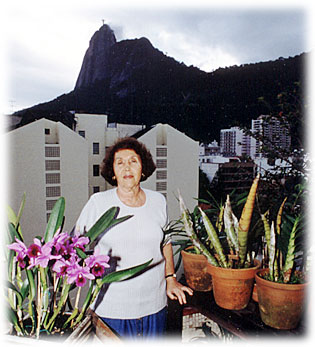

| Maria
da Penha Fagnani A physician graduated from the old National College of Medicine (Nowadays Federal University of Rio de Janeiro), in 1957. Some years before retiring, looking for developing her knowledge about orchids, she attend the main Botany subjects at the University of Santa Ursula, in Rio de Janeiro, which helped her in the identification and comprehension of some biological aspects of those so special plants. |
 |
Maria da Penha Fagnani is not only a serious orchid grower but also a researcher of the Orchidaceae family who has been adding a lot to the knowledge about the orchids from the state of Rio de Janeiro. Meticulous as every scientist, she always looks for adjusting in the best way possible the environment to cultivate the species she choose, trying to reproduce as close as possible the plant's habitat. In this search of perfection, she prefers to cultivate a smaller number of plants and obtain a high index of successful and realization of the blooming potential of each plant. She has been giving a precious collaboration through her studies in the identification of the species of the state of Rio de Janeiro and in the knowledge of their habitats. The studies of the sandbank of Massambaba and Bananal River stand out, both published in Orquidário, the magazine of OrquidaRio (our local society). |
|
The first
work has been presented during the XV World Orchid Conference and published
in the Proceedings. The second has also been the subject of Orchid
News nº 2. In the identification of species of orchids, she collaborates with entities such the Department of Botany of University of Santa Ursula and Botanical Garden of Rio de Janeiro. |
| ON-
- How did you start cultivating orchids? Which was the magic moment of attraction? MPF- There was not a specific moment but a progressive interest, provoking mainly by the possibility of cultivating and, at the same time, enjoying other aspects of the orchidophilie, such as meeting interesting people and the scientific side, for example. ON- How long have you been cultivating orchids? MPF- By curiosity and esthetic, long time ago but, as an orchidist, since sixteen years ago. |
| ON- Where do you cultivate your plants? |
| MPF-
In the porch of my penthouse in Botafogo, in an area of 30 m², in the
8th floor. There is a strong luminosity and sun from 10:30 o'clock in the
morning until the sunset, it is well ventilated place with strong winds,
sometimes. The plants are partially protected by a trellis, a shelter and an awnings. During the winter, the plants stay more exposed to direct sunlight, without the protection of the awnings. From my place I can see Corcovado so my environment is benefited a little by the |
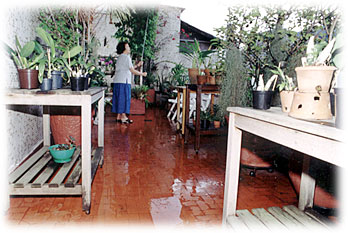 |
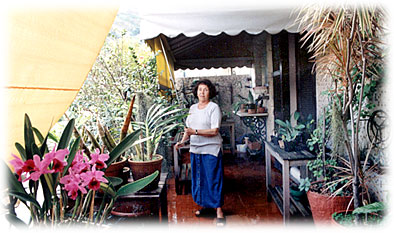 |
humidity comes from the wood next to mountain. To improve the cultivation condition, I have small trees planted in big pots, such Brazilian fruit-trees: jaboticabeira, pitangueira and some others that besides to improve the humidity, they are also used as supports for orchids and bromeliads. Between the bromeliads, I point out the Tillandsia usneoides (also known as "old man beard" ) which does not retain water and grows at any place, hanging with its garlands. |
| ON-
How many plants do you have? MPF- Nowadays I have less than a hundred plants. I used to have more than two hundreds but I should do a repair in the porch, so I gave or lost many things. I am starting again to buy and to accept new plants, without excess. ON- Which orchids do you have more? MPF- Nowadays, I stay with those which fit well with my micro-climate such some Cyrtopodium, Cycnoches, Mormodes, Catasetum, some Dendrobium and some others. |
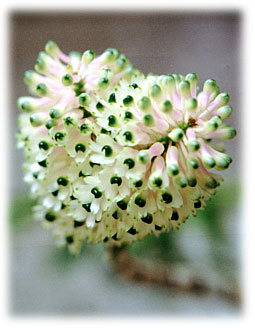 Dendrobium smillieae |
ON-
Between yours, what is the favorite plant? MPF- By this moment, I am delighted with the result I got with the cultivation of Dendrobium smillieae F. Muell. I bought it from Cristina Miranda, a small plant with a few pseudobulbs, in 1997. The plant throve quickly and in September 1999, it bloomed for the first time. In the Spring Show of 2000, it got the first place and, to complete my satisfaction, it has been the cover of the Orquidário magazine # 14. Nowadays, it is a vigorous specimen that I cultivate without much trouble, under direct sunlight, however during the summer, I keep it protected from the afternoon sunlight. |
| ON-
Which Brazilian genera do you have in your collection? MPF- Anacheillum (*), Brassavola, Brassia, Catasetum, Cyrtopodium, Cycnoches, Epidendrum, Leptotes, Liparis, Miltonia, Maxillaria, Mormodes, Oncidium, Pleurothallis, Sophronitis. ON- How long do you spend taking care of your orchids, daily? MPF- It varies a lot, depending on the season of the year and what I need to do. As I have a few plants, I spend from half an hour until few hours with them. |
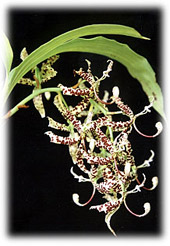 Cycnoches pentadactylum 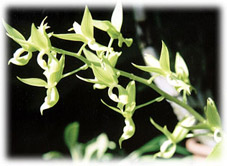 Mormodes elegans |
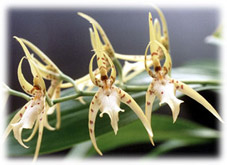 Brassia lawrenciana 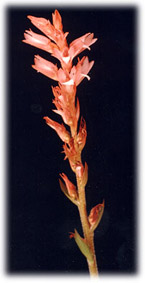 Stenorrhynchus lanceolatum (**) |
|
ON-
You said that there was not a specific moment of attraction, but which
was the factor (a person or an event)
that influenced in your feelings
regarding to the orchids ? |
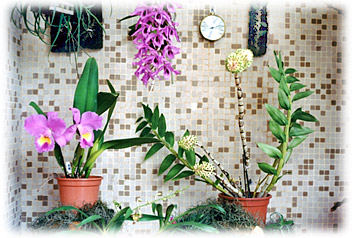 |
ON-
Which are the climatic conditions found in your environments? MPF- During the summer, the maximum temperature is 36º; during the winter, the minimum is 18º; there is a strong luminosity all day around and, mainly, in the afternoon. The floor is made of ceramic tiles and the wall is revestida de pastilhas, which, with the strong occasional wing, make the natural humidity deficient however I have some expedients, as I have already said, that make the cultivation possible. |
| ON- Do you have a cultivation tip to share with us? MPF- The use of tables with lathes and casters made a big difference in my cultivation because they make easy the upkeep the displacements of the plants to follow the incidence of sunlight according to the seasons. It is also very important to learn how to control the wish for having more plants than my room can bear or more than the cultivation conditions allow, included knowing when getting ride of the diseased plants or plants infected with virus, for example. |
| ON- Is there a short or amusing story connected to orchids that you want to tell us? |
| MPF- One of my Cyrtopodium paranaense (***) was beautifully bloomed and exhaling an intense scent during the morning. Before going out to go to a bank, I stopped to admire it and when I was in the queue of the bank, I started to feel a sentir, as it was next to me, the sweetish and slight acid scent of the flowers and the plant didn't get out my head as it was calling me. I came home and went straigth to see the plant: the wire of a kite was twisted around the floral spikes and was about to break them. I unwound the wire and I felt the plant thanked me. |
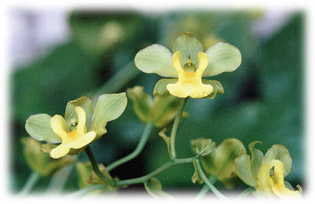 Cyrtopodium
paranaense Cyrtopodium
paranaense |
| ON-
One said that orchidophilia is a soft manifestation of madness. Have you
done any "orchidophilic" insanity? MPF- Some times the anxiety for finding orchids in their habitats in order to register the occurrence and study them put me in danger. The worst situation I lived was when we were on the run from the bees, we got into the river, in Lumiar (Friburgo, state of Rio de Janeiro). There, sometimes, the rivers have currents and one of them took me. I succeeded in getting a stone and just got out with the help of the people from the region, with my knee hurt. I perpetrated the usual madness of spending more money than I could spend with the plants which are sometimes inadequate to my conditions of cultivation, such as Sophronitis coccinea, for example. |
|
(*)
(**) (***) |
synonym
of Prostecheae. synonym of Sacoila lanceolata. synonym of Cyrtopodium polyphyllum. |
| Photographic
credits : Photos of Maria da Penha: Carlos Ivan Siqueira All others photos: Maria da Penha Fagnani |
|
Any kind of reproduction (print, digital or anyone other) of any type
of material of this site - texts, lay-out, photos, images and others
- is strictly forbidden without the previous written permission of the
authors.
Any solicitation or information should be done by the e-mail bo@sergioaraujo.com |
|
back
|